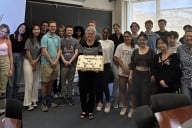You have /5 articles left.
Sign up for a free account or log in.
This semester I am teaching Law, Policy and Politics of AI. For all my classes, I begin with Lawrence Lessig’s four-factor analysis: law, markets, social norms and technology. That all seems fine until I explain how these factors take shape in time and space. Last week I fell down a big rabbit hole on the rise of corporations in American history as a way of explaining the peculiar role that corporations play in contemporary society. I have also been mulling an explanation of the relationship between corporations and government in the market-driven economy of the U.S. Instead of indulging in the whole of American history since the Civil War, here is a little essay I wrote. The purpose, as you will read at the end, is to situate AI and the challenges it presents, both catastrophic (labor, bias, disinformation, privacy, polarization—Fei-Fei Li of Stanford) and existential (end of humanity—Geoff Hinton, formerly of Google and the University of Toronto). How do you think I did?
The end of slavery and the unification of the country under a single political economy, together with urbanization, industrialization and immigration, laid the foundation for the rapid growth of corporations in the second half of the 19th century and the rise of manufacturing in the 20th. The absence of governmental controls over the accumulation of wealth, wages and labor conditions, in concert with the exploitation of farmers economically disenfranchised by the shift in economic power from an agricultural to an industrial society, were largely considered the costs of a free market, costs well worth the overall progress of the country under capitalism.
Called the Gilded Age, it is known for its rapid accumulation of wealth. It marks the rise of banks (J. P. Morgan), railroads (Vanderbilts) and industry (Ford). Challenges emerged from those costs, however, in the form of labor unrest, the suppression of ex-slaves in the South and the wide divide between the wealthy and the working class. Social movements such as organized labor (the AFL and then later the CIO), progressive politics to tax income (16th Amendment), the direct election of senators (17th Amendment) and women’s suffrage (19th Amendment) occurred as well. Those progressive measures helped to usher in child labor, wage and working condition laws and welfare and Social Security in the 1930s during Franklin Roosevelt’s New Deal programs.
Throughout both the expansion of business and the emergence of progressive social movements, corporations continued to rise in the United States. Industrial production in the Second World War further accelerated their growth. Following WWII, the Cold War ensured that corporations worked with the interests of the United States for access to source materials globally (e.g., rubber in Asia) and in a contest against communism (which threatened to nationalize corporations). It was not until the fall of the Soviet Union that the transnational nature of America corporations came out in more bold relief. With the Cold War no longer a factor in aligning corporate and government goals, corporations began taking measures in keeping with their fiduciary roles (to make money for shareholders) but not the interests of the working people of America.
Outsourcing, for example, resulted in the massive loss of manufacturing jobs and other blue-collar employment. A free market economy that relied on government noninterference furthermore held no promise to disenfranchised workers. The government had no obligations to retrain, relocate or compensate the working class for their losses, just as a century before the government did nothing to help disenfranchised farmers. Yet the loss of jobs rankled the assumptions of working-class people, who had come to believe that a middle-class life (homeownership, some luxuries such as cars or vacations, and college education and upward mobility for their children) was a birthright. Offshoring, the banking of profits outside the jurisdiction of U.S. tax laws, is another example of corporations pursuing their interests at the expense of American society. Offshoring increased corporate coffers, but the drop in taxes for the U.S. Treasury depleted monies needed to fund social programs.
In the 1980s, the Reagan administration further depleted funds by cutting taxes. (President Trump dramatically enhanced those tax cuts in 2017.) Increasingly the interests of government and corporations diverged. As real wages began to fall in the late 1970s, taxes rose on the middle classes to compensate for the losses of corporate and individual income taxes on the wealthy. Social relations between the extreme wealthy and the poor sharpened. Working-class people began to inquire why the very poor had government protection in welfare and medical care, but they did not, especially as they witnessed their place in the social order slipping. All too frequently, rhetoric around these issues drew on racists stereotypes, reviving racism in an era when the civil rights movement had hoped for gains, not losses, going forward. No one blamed corporations. Everyone wanted corporations to thrive. Corporations were the locus of employment and opportunity. They weren’t supposed to be responsible for the well-being of citizens. Citizenship was a relationship that individual had with the government. Blame therefore fell predominantly on that sector.
This blame occurred notwithstanding fundamental contradictions inherent in the role of government in a free market society. Government was not designed to take care of people; that is what socialism promised, but American society rejected that notion and associated socialism with totalitarian regimes (the Soviet Union, China and Cuba, for example). Policy advisers to the social programs of the New Deal (1930s) and the New Society (1960s) designed them to take the edge off the extremes of poverty; they were not expected to be made available to everyone. Having embraced capitalism, American culture expected full-bodied people to make it on their own, no matter what class anyone was born into or what race they were and how history framed their experience. Cultural notions of “rags to riches” dominated the individualistic mindset of the society.
Still, people who had their expectations of a middle-class life dashed increasingly looked for someone to blame. Politicians answer to the people in a democracy, and therefore they became the most obvious target. Corporations, on the other hand, do not and are not expected to behave as democracies. Corporate leadership of publicly traded companies answer to stockholders, not the American public. Corporate leaders do not announce their global strategies to the American public, nor do they put their decisions up for a public vote.
Thus, as the 20th century ended and Big Tech emerged along with the commodification of information that moved global economies, corporations skirted both blame and responsibility for decisions that they made against the interests of the American people, whether in terms of jobs overseas (manufacture of the iPhone), automation in the distribution of goods (Amazon) or the collection of information about consumers (Microsoft, Meta and Google, especially) against privacy interests. Big Tech corporations have had to pay some penalties to the government for egregious lapses (Meta, Cambridge Analytica), but nothing that their operating costs cannot absorb. For the most part, Big Tech corporations have continued their business interests without biting regulation and with tremendous financial gain. Government, in the meantime, has become increasingly polarized, to the degree of violent protests and congressional paralysis.
It is into this landscape that AI has emerged and must be evaluated. Media and popular opinion tend to talk about AI as a technology, as if it exists apart from the law, social norms and the market. If I have tried to do anything so far in our course, I have tried to drive home the point that the only way we can fully understand the significance of AI and its disruptive characteristics, both catastrophic and existential, that threaten other aspects of society or our very humanity, is to recognize how these forces shape AI and how AI may come to influence those forces. I hope this little essay has helped to deepen your understanding of this challenge.






